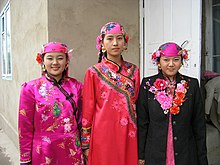Dungans
The Dungans ( Chinese 東 干 族 , Pinyin dōng gān zú ; Russian Дунгане ) are a Muslim - Chinese minority who mainly live in the Central Asian successor states of the Soviet Union . Their language, a Chinese dialect , is Dungan (東 干 語); the two main dialects are the Gansu and Shaanxi dialects. There are around 110,000 Dungans worldwide.
Origin of the ethnic groups
The term "Dunganen" is used today for Hui Chinese who have left China and live in Central Asia. It seems to be primarily a foreign name for these population groups (see origin of the term), which has now developed into an independent name. Before the founding of the People's Republic, the term z. Sometimes also used for the Hui within China.
Dungans are found particularly in Kyrgyzstan and Kazakhstan , while smaller minorities also live in Uzbekistan and Russia . The ancestors of these groups were Hui Chinese who fled China during the Muslim uprisings of the 1970s and 1980s . Dungans are predominantly of Han Chinese origin with a common religion, Islam.
Isolation from the centers of Islam also led to deviations in religious practices.

Hui uprisings of the 19th and 20th centuries Century
On the circumstances that led to emigration from China in the 19th century:
In 1818, 1834–1840, and 1855–1873, the Muslims rose in Yunnan . The uprising, triggered by the economic rivalry between Han Chinese and Muslim workers, was brutally suppressed (the so-called Panthay rebellion ), and one million people lost their lives. From 1862 to 1878 the provinces of Shaanxi , Gansu and Xinjiang saw the so-called " Dungan uprisings " against Chinese rule, which ran parallel to the Hodscha uprising in Kashgaria (cf. Jakub Bek ), temporarily creating independent areas and ultimately an estimated 10 Claimed millions of dead. In the following decade there was an increased emigration of Muslims to the Tsarist Empire.
The suppression of these uprisings increased the tendency to create separate residential areas and to pursue professions typical of these ethnic groups. Around 1937 riots broke out again among the Hui in Gansu, under Ma Zhongying (马仲英), who threatened to spread to Xinjiang.
Language / writing
- Main article: Dungan language
Most Dungans still speak Dungan as their mother tongue and Russian as a second language. The Dungan language is one of the Sino-Tibetan languages and is very similar to the North Chinese dialects ( Mandarin ). However, it is unique because it has been using the Cyrillic alphabet since 1953 . Previously, the language was written in Arabic and at times also in Latin.
Origin of the term
The origin of the term "Dunganen" is uncertain, but is possibly based on the Turkish döñän / dönen (" convert "). The Hui , which are widespread in western and central China, are called "Dungan" by Turkish- and Tajik-speaking neighbors. The word can also have a reference to the Chinese province (eastern) Gansu (东 干), which was inhabited by many Dungans in the 19th century.
Well-known Dungans
- Maija Manesa , weightlifter
- Yassyr Schiwasa , poet and writer
- Sulfija Tschinschanlo , weightlifter
See also
Web links
- Mark Swofford: Implications of the Soviet Dungan Script for Chinese Language Reform . pinyin.info, April 14, 1989 (On the Dungan Alphabet: a stimulating essay on the question of whether you can write Chinese without Chinese characters; English)
- Chinese Culture: The “Shaanxi Village” in Kazakhstan. CRIENGLISH.com, July 9, 2004, archived from the original ; accessed on September 22, 2017 (English).
Individual evidence
- ^ Günter Kettermann: Atlas for the history of Islam . Primus-Verlag, Darmstadt 2001, ISBN 978-3-89678-194-9 , p. 127 (Islam in China).
- ↑ Fischer Weltgeschichte , Vol. 15, p. 291.
